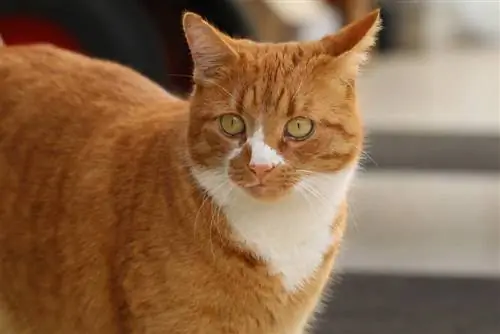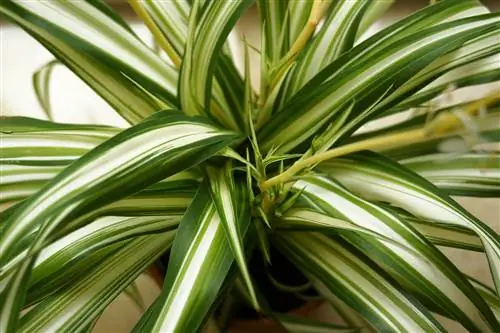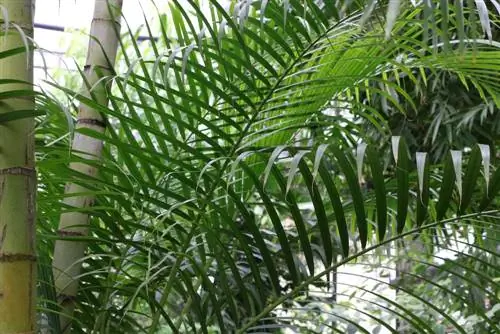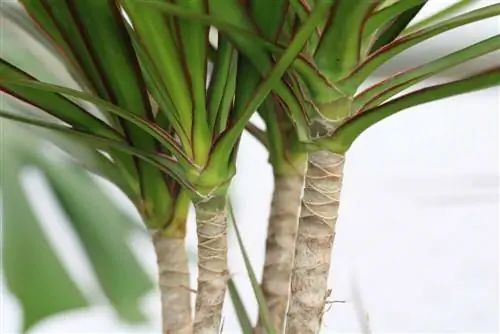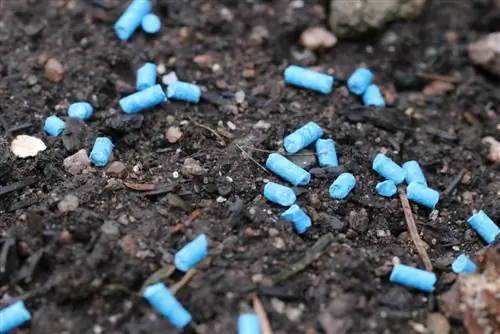- Author admin [email protected].
- Public 2023-12-17 03:39.
- Last modified 2025-06-01 06:48.
“Cats naturally know what is good for them or not” - but many cats have forgotten this, which is why cat owners should know which plants are poisonous to cats. Below you will learn about the houseplants that are really dangerous for cats and a few other household poisons. You will also learn why some poisons are not poisons at all and what even experienced outdoor cats should be careful of.
Profile “Cats and Poison”
Cats initially react to the same poisons as all mammals. That's why many of the poisonous plants mentioned also appear in lists of poisonous plants for humans, dogs and cattle. However, it should be noted that a 4 kg cat is much more sensitive than a 30 kg dog or 75 kg human.
Furthermore, every mammal has species-specific sensitivities. Currently a field of ongoing discoveries and new differentiations. Newly published articles on “Cats and Poison” are therefore essential reading for cat owners.
However, new poisons (on “internet cat sites”) should be viewed with caution. Maybe it's neither new nor dangerous for cats, but just "reader poison" (=not/poorly/incorrectly researched information).
Plants poisonous to cats A-K
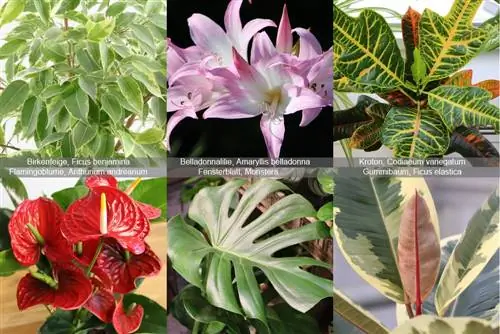
There are so many poisonous plants that the list would no longer be able to be looked through quickly enough in an emergency. That's why only plants that your cat really shouldn't snack on are listed below:
- Aloe, Aloe spec., moderately toxic
- Cyclamen, Cyclamen persicum, moderately poisonous
- Amaryllis, Hippeastrum spec., moderately poisonous
- Aralie, Aralia spec., moderately poisonous
- Aron Calyx, Zantedeschia aethiopica, moderately poisonous
- Avocado, Persea gratissima, poisonous, gastrointestinal symptoms + pancreatitis
- Azalea, see Rhododendron, highly poisonous
- Belladonna lily, Amaryllis belladonna, highly poisonous
- Birch fig, Ficus benjamina, moderately poisonous
- Bow hemp, Sansevieria trifascata, moderately poisonous
- Brunfelsia, Manaka, Brunfelsia sp. medium toxic
- Buntwurz, Caladium bicolor, moderately poisonous
- Dieffenbachia, Dieffenbachia senguine, highly poisonous
- Dragon tree, Dracaena drago, moderately poisonous
- Ivy plant, Scindapsus spec., moderately poisonous
- Single leaf, Spathiphyllum floribundum, moderately poisonous
- Window leaf, Monstera spec., moderately toxic
- Ficus, Ficus spec., moderately poisonous
- Flamingo flower, Anthurium spec., moderately poisonous
- Flaming Käthchen, Kalanchoe spec., medium poisonous
- Rubber tree, Ficus elastica, moderately poisonous
- Sky blossom, Duranta erecta highly poisonous
- Cocoa tree, Theobroma cacao, highly poisonous
- Caladia, Caladium bicolor, moderately poisonous
- Kalanchoe, Kalanchoe spec., moderately poisonous
- Camellia, Camelia sp., leaves of the tea bush contain caffeine, toxic in large quantities
- Klivia, Klivia miniata, moderately poisonous
- Flounder thread, Aglaonema commutatum, moderately toxic
- Coral tree, Solanum pseudocapsicum, moderately toxic
- Croton, Codiaeum variegatum, highly poisonous
Poisonous plants M-Z

- Macadamia, Macadamia integrifolia, poisonous, mechanism of action unknown, muscle tremors, lameness, joint stiffness, high fever
- Cyca fern, Cycas spec., moderately poisonous
- Palm lily, Yucca elephantipes, moderately poisonous
- Philodendron, Philodendron spec., moderately poisonous
- Magnificent lily, Gloriosa superba, highly poisonous
- Purple Tute, Syngonium podophyllum, moderately poisonous
- Riemenblatt, Clivia miniata, medium poisonous
- Ritterstern, Hippeastrum spec., medium poisonous
- Crown of Glory, Gloriosa rothschildiana, highly poisonous
- Schellenbaum, Thevetia peruviana highly poisonous
- Skeleton leaf, Begonia spec., moderately toxic
- Pigeonberry, Duranta erecta highly poisonous
- Tropical oleander, Thevetia peruviana, highly poisonous
- Poinsettia, Euphorbia pulcherrima, highly poisonous, the existing non-toxic varieties cannot be distinguished from the toxic ones.
- Wonder bush, Codiaeum variegatum, highly poisonous
- Desert rose, Adenium obesum, highly poisonous
- Yucca, Yucca elephantipes, moderately poisonous
- Ornamental pepper, Capsicum annuum, whole plant highly poisonous, fruits contain only a few alkaloids
- Aralia, Fatsia japonica, moderately poisonous
- Room calla, Zantedeschia aethiopica, moderately poisonous
Tip:
It's not just substances that cats accidentally ingest that can be dangerous to the animals. But also substances that people apply to fur/skin to ward off parasites (in too high a dose). Two cats died from an infusion containing pyrethroids that their owner, with good intentions, massaged into their fur to ward off vermin. The pyrethroids / pyrethrins (and other poisons that serve the same purpose) that are sold to ward off external parasites can also be used as collars, shampoos, spot-on preparations, dipping baths and ear clips.
The cat-hazardous household
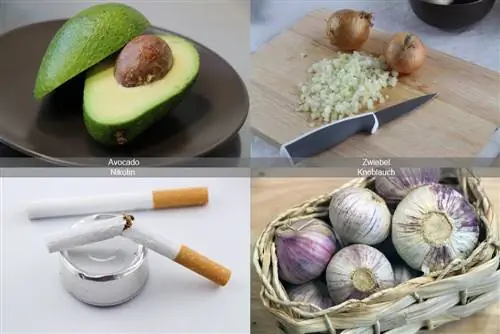
“Most accidents happen at home”; Most poisonings probably do too, because it's not just house plants that can be dangerous for cats, but a whole lot of everyday substances in the household:
- Avocados: toxic, gastrointestinal symptoms + pancreatitis
- Yeast dough / raw sourdough: alcohol poisoning
- Cocoa, chocolate: highly toxic
- Garlic: poisonous in quantities
- Macadamia nuts: poisonous, mechanism of action unknown, muscle tremors, lameness, joint stiffness, high fever
- Milk: Like human rearing food, which causes vomiting and diarrhea in many adult individuals
- Raisins: highly toxic, from 2.6 g of raisins per kg of body weight, kidney failure possible, reason unknown
- Tobacco: highly toxic, 5-25 g of tobacco or a cigarette butt can kill a cat
- Tea tree oil: incompatible, the cat's body can hardly break down the phenols and terpinenes it contains
- Grapes: highly toxic, from 10 g of grapes per kg body weight Kidney failure possible, reason unknown
- Xylitol (sweetener): Harmful by increasing insulin secretion, resulting in a life-threatening drop in blood sugar levels
- Onion: poisonous, also cooked in larger quantities
New poison=new danger for cats?
If you inform yourself about toxins that could harm your cats, you will hardly be able to avoid the “poisonous walnuts” at the moment, which then often lead to the “poisonous Roquefort”. The newly discovered, dangerous mold toxin “Roquefortin,” which is currently making the rounds on “cat sites” on the Internet, is to blame. This “new dangerous poison” is neither new nor dangerous: The first publications on Roquefortin C are almost 30 years old, when the fungal toxin was first isolated from a Penicillium roqueforti strain. Penicillium roqueforti is the mold that has ensured that these cheeses contain the typical blue veins since 1060 (Roquefort), 11th century (Gorgonzola), 1730 (Blue Stilton), early 20th century (Danish Blue) without humans or Cats typically die after eating these cheeses in large quantities.
The walnut itself is not depicted as poisonous on the cat pages, the nut shell is only said to be frequently attacked by Penicillium roqueforti fungi that produce roquefortine, with bad consequences according to the cat pages: “Roquefortin has a toxic effect on vertebrates, a neurotoxin, leads to In the worst case, cramps can lead to death", regarding Roquefortin in Roquefort cheese, "without being able to give any information about the amounts of toxins contained" it is advised to "make sure that the cat never eats Roquefort cheese" (consciously in the sense and not with exactness). Text quoted because it is not about denigrating the websites of committed cat lovers, but rather about poison information for cat lovers that does not cause unnecessary fear).
The cheese-loving Roquefort friend with a cat will definitely be so unsettled after reading these pages that he will consider serving the next cheese platter for the party buffet without any blue cheese or moving the cats out during the party. What a shame it would be for the guests or the cats - the whole walnut-cheese poison claim calls for a few facts that would help better classify the toxicity of walnuts, cheese and the like.
These facts can be found on the Internet: In 2001, a group of US scientists looked into Roquefortin C in cheese, loosely translated: “Roquefortin C content in cheese between 0.05 and 1.47 mg/kg low content and “low toxicity of roquefortin C makes consumption of blue cheese safe for consumers” (www.ncbi.nlm.nih.gov/pubmed/11271775). A TU Munich dissertation from 2005 on the “Influence of Roquefortin C on animal he alth” lists all the toxicity data previously researched on Roquefortin C: In 4 studies, laboratory mice received up to 189 mg of Roquefortin C per kg of body weight, without any neurological changes being detected, one study killed (perhaps not so fit) laboratory mice with “only” 100 mg per kg body weight (mediatum.ub.tum.de/doc/603663/603663.pdf).
Of course, any cautious scientist/cat lover will rely on the fatal study when it comes to the quantities that cats can safely consume. These can be calculated: If your cat completely consumes a standard 100 g pack of Roquefort, it will consume 0.005 to 0.147 mg of Roquefortin C. It becomes dangerous for a normal 4 kg cat from 400 mg of Roquefortin C, so the cat would have to consume 272 kilograms of Roquefort (and similar amounts of walnut shells, there is probably much less Roquefortin C in the nuts themselves) in order to Dying from Roquefortin C poisoning. Based on this calculation, even cautious scientists/cat lovers can assume that Roquefortin C cannot kill cats because they would burst through too much blue cheese and committed cat lovers are asked not to “invent new poisons” for the good of everyone, but either to research or simply leave out the material in question.
Tip:
Cats are victims of poisoning, but statistically it is very rare. Cats often suffer from the consequences of a diet consisting only of processed food. According to many critics, what is sold in (expensive) mini containers with parsley on the lid belongs in a completely different container (without parsley on the lid, also known as a garbage can). This is less about meat parts that are only used in pet food, such as innards, heads and legs; People with access to he althy meat should share these with their cat more often because they contain more/different ingredients than the muscle meat they would otherwise eat. It's about the fact that meat products from conventional factory farming can also contain, as "cat meat", everything that increasingly detracts from sensitive people's enjoyment of (cheap) meat, but is metabolized in the cat by an organism that is around 20 times smaller. If you find out about he althy cat nutrition without ready-made food, you can also feed your cats much more cheaply.
Poisonous threats to outdoor animals
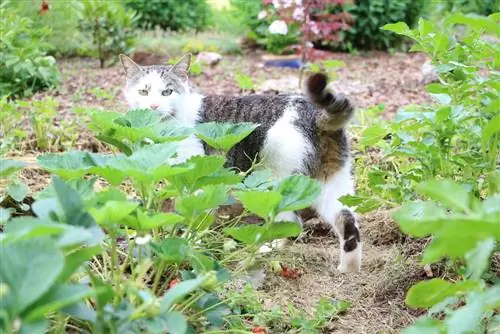
Do you have an outdoor animal at home who could poison himself anywhere outside? Theoretically safe, but in practice, real outdoor animals that get along well outside don't necessarily put everything they come across in their mouths. Especially not when it comes to freedom, where there are really more exciting things at stake. If you would like to get a brief overview of which plants cats can theoretically be poisoned by, you will find long lists in the articles on poisonous plants for dogs and horses (after consuming most poisonous substances, all mammals, including humans, drop dead together, only the quantities differ).
However, there are two scenarios in today's environment that require special attention and can potentially harm even the smartest cats:
Invasive Neophytes
Even a seasoned outdoor animal who can easily deal with every cat hooligan in the area has no scientific training in botany that would prepare him for contact with plants from foreign countries.
Or rather avoid contact with plants from foreign countries, because any skin contact with the pretty white umbelliferous plants (Hercules perennials) can end in bad, burn-like, poorly healing wounds. Botany lessons for the cat won't do much good, but it makes sense to ask your community why the dangerous stuff hasn't been razed to the ground yet. This also applies to Hercules perennials on private property: property is obliged, for example, to keep the plants in one's garden in a condition that does not harm people walking, jumping, sneaking (driving, flying, etc.) past or over them.
You can also ask the municipality whether other invasive neophytes are under special observation in your area, which can (also) be dangerous to cats.
Aggressive Citizens
If you let your cat run around outdoors in spring without a bell collar, it should be a leisurely specimen that no one would trust to chase a few meters quickly. Otherwise, in our increasingly intolerant society, there is always the danger that an overzealous bird conservationist will want to protect the birds by murdering cats.
If an overzealous bird protector is encouraged to commit (mis)deeds by hunting cats, poison bait is often used. The first to succumb are the plump, leisurely (eating) cats, which can just about hunt down a snail. In addition, all cat owners in the area have a lot to do with keeping cats busy instead of letting them go outside, looking for poison bait, etc. Always pay attention to the cat owner conversations, news, and forums in your area. If bait is laid somewhere, the word usually spreads around very quickly.
Tip:
You don't like this intervention in evolution, cats hunt birds? Yes, of course, the birds would be able to deal with this without any problems (statistically speaking, the catch rates of domestic cats are shamefully low) if they hadn't been put in distress by the “few thousand” human interventions here: www.youtube.com/watch?v=mLByIqmvvtk explains why our songbirds are dying out and what you can do about it, even if domestic cats aren't the problem. The songbirds definitely thank you for every bell collar.

